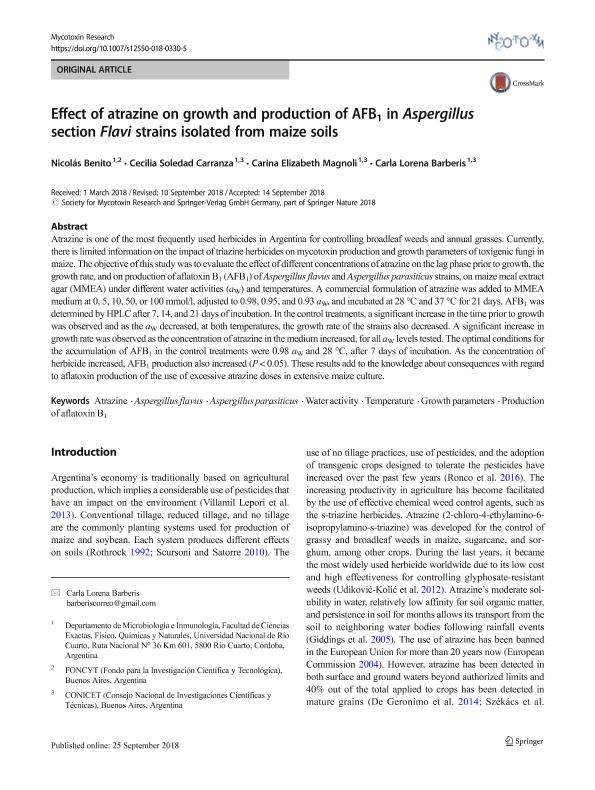Mostrar el registro sencillo del ítem
dc.contributor.author
Benito, Nicolas

dc.contributor.author
Carranza, Cecilia Soledad

dc.contributor.author
Magnoli, Carina Elizabeth

dc.contributor.author
Barberis, Carla Lorena

dc.date.available
2020-04-20T20:16:01Z
dc.date.issued
2018-09
dc.identifier.citation
Benito, Nicolas; Carranza, Cecilia Soledad; Magnoli, Carina Elizabeth; Barberis, Carla Lorena; Effect of atrazine on growth and production of AFB1 in Aspergillus section Flavi strains isolated from maize soils; Springer Verlag; Mycotoxin Research; 35; 1; 9-2018; 55-64
dc.identifier.issn
1867-1632
dc.identifier.uri
http://hdl.handle.net/11336/103081
dc.description.abstract
Atrazine is one of the most frequently used herbicides in Argentina for controlling broadleaf weeds and annual grasses. Currently, there is limited information on the impact of triazine herbicides on mycotoxin production and growth parameters of toxigenic fungi in maize. The objective of this study was to evaluate the effect of different concentrations of atrazine on the lag phase prior to growth, the growth rate, and on production of aflatoxin B1 (AFB1) of Aspergillus flavus and Aspergillus parasiticus strains, on maize meal extract agar (MMEA) under different water activities (aW) and temperatures. A commercial formulation of atrazine was added to MMEA medium at 0, 5, 10, 50, or 100 mmol/l, adjusted to 0.98, 0.95, and 0.93 aW, and incubated at 28 °C and 37 °C for 21 days. AFB1 was determined by HPLC after 7, 14, and 21 days of incubation. In the control treatments, a significant increase in the time prior to growth was observed and as the aW decreased, at both temperatures, the growth rate of the strains also decreased. A significant increase in growth rate was observed as the concentration of atrazine in the medium increased, for all aW levels tested. The optimal conditions for the accumulation of AFB1 in the control treatments were 0.98 aW and 28 °C, after 7 days of incubation. As the concentration of herbicide increased, AFB1 production also increased (P < 0.05). These results add to the knowledge about consequences with regard to aflatoxin production of the use of excessive atrazine doses in extensive maize culture.
dc.format
application/pdf
dc.language.iso
eng
dc.publisher
Springer Verlag
dc.rights
info:eu-repo/semantics/openAccess
dc.rights.uri
https://creativecommons.org/licenses/by-nc-sa/2.5/ar/
dc.subject
ASPERGILLUS FLAVUS
dc.subject
ASPERGILLUS PARASITICUS
dc.subject
ATRAZINE
dc.subject
GROWTH PARAMETERS
dc.subject
PRODUCTION OF AFLATOXIN B1
dc.subject
TEMPERATURE
dc.subject
WATER ACTIVITY
dc.subject.classification
Micología

dc.subject.classification
Ciencias Biológicas

dc.subject.classification
CIENCIAS NATURALES Y EXACTAS

dc.title
Effect of atrazine on growth and production of AFB1 in Aspergillus section Flavi strains isolated from maize soils
dc.type
info:eu-repo/semantics/article
dc.type
info:ar-repo/semantics/artículo
dc.type
info:eu-repo/semantics/publishedVersion
dc.date.updated
2020-03-13T18:08:44Z
dc.identifier.eissn
0178-7888
dc.journal.volume
35
dc.journal.number
1
dc.journal.pagination
55-64
dc.journal.pais
Alemania

dc.description.fil
Fil: Benito, Nicolas. Universidad Nacional de Río Cuarto. Facultad de Ciencias Exactas Fisicoquímicas y Naturales. Instituto de Investigación en Micología y Micotoxicología. - Consejo Nacional de Investigaciones Científicas y Técnicas. Centro Científico Tecnológico Conicet - Córdoba. Instituto de Investigación en Micología y Micotoxicología; Argentina
dc.description.fil
Fil: Carranza, Cecilia Soledad. Ministerio de Ciencia. Tecnología e Innovación Productiva. Agencia Nacional de Promoción Científica y Tecnológica; Argentina. Universidad Nacional de Río Cuarto. Facultad de Ciencias Exactas Fisicoquímicas y Naturales. Instituto de Investigación en Micología y Micotoxicología. - Consejo Nacional de Investigaciones Científicas y Técnicas. Centro Científico Tecnológico Conicet - Córdoba. Instituto de Investigación en Micología y Micotoxicología; Argentina
dc.description.fil
Fil: Magnoli, Carina Elizabeth. Universidad Nacional de Río Cuarto. Facultad de Ciencias Exactas Fisicoquímicas y Naturales. Instituto de Investigación en Micología y Micotoxicología. - Consejo Nacional de Investigaciones Científicas y Técnicas. Centro Científico Tecnológico Conicet - Córdoba. Instituto de Investigación en Micología y Micotoxicología; Argentina
dc.description.fil
Fil: Barberis, Carla Lorena. Universidad Nacional de Río Cuarto. Facultad de Ciencias Exactas Fisicoquímicas y Naturales. Instituto de Investigación en Micología y Micotoxicología. - Consejo Nacional de Investigaciones Científicas y Técnicas. Centro Científico Tecnológico Conicet - Córdoba. Instituto de Investigación en Micología y Micotoxicología; Argentina
dc.journal.title
Mycotoxin Research
dc.relation.alternativeid
info:eu-repo/semantics/altIdentifier/url/http://link.springer.com/10.1007/s12550-018-0330-5
dc.relation.alternativeid
info:eu-repo/semantics/altIdentifier/doi/https://doi.org/10.1007/s12550-018-0330-5
Archivos asociados
